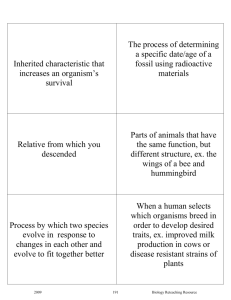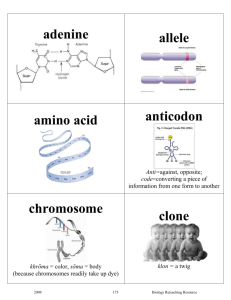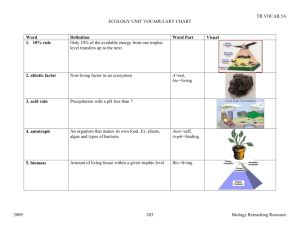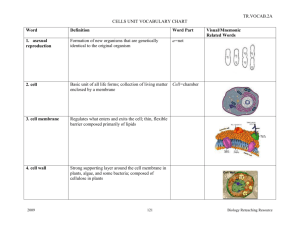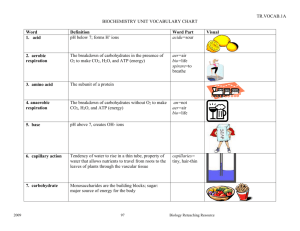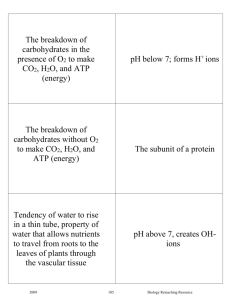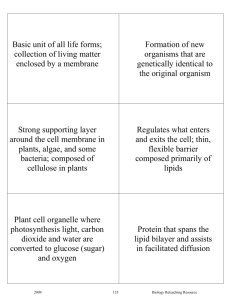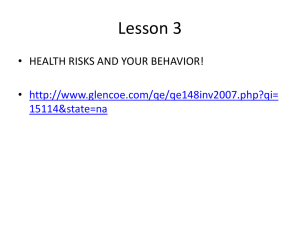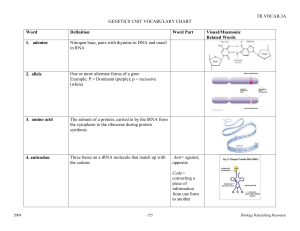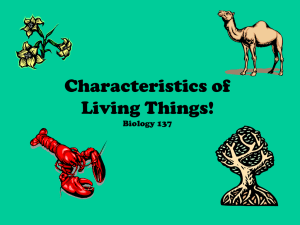BCPS Biology Reteaching Guide Evolution Vocab Chart
advertisement
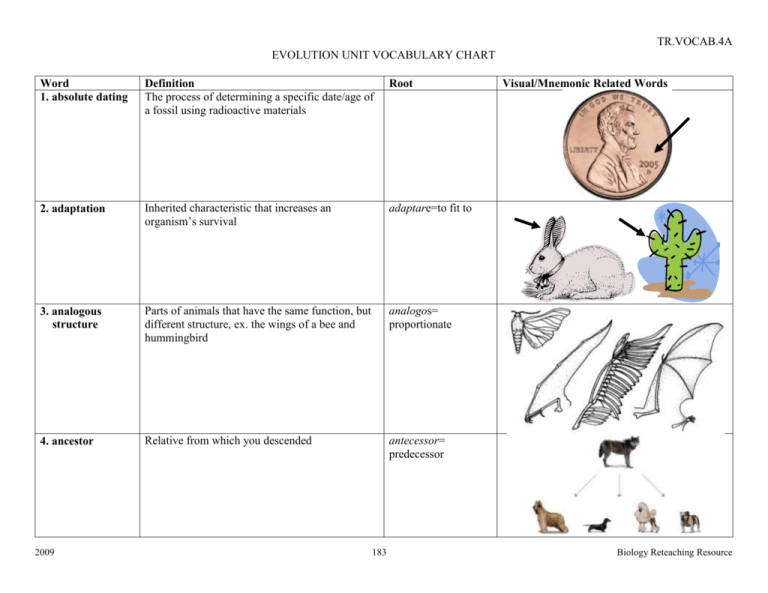
TR.VOCAB.4A EVOLUTION UNIT VOCABULARY CHART Word 1. absolute dating Definition The process of determining a specific date/age of a fossil using radioactive materials Root 2. adaptation Inherited characteristic that increases an organism’s survival adaptare=to fit to 3. analogous structure Parts of animals that have the same function, but different structure, ex. the wings of a bee and hummingbird analogos= proportionate 4. ancestor Relative from which you descended antecessor= predecessor 2009 183 Visual/Mnemonic Related Words Biology Reteaching Resource TR.VOCAB.4A 5. artificial selection EVOLUTION UNIT VOCABULARY CHART When a human selects which organisms breed in artes=something order to develop desired traits, ex. improved made milk production in cows or disease resistant strains of plants 6. coevolution Process by which two species evolve in response to changes in each other and evolve to fit together better co=with, together 7. convergent evolution When distantly related organisms live in similar environments and independently start to develop similar (analogous) structures, ex. the dolphin and shark, have similar fins convergere=together 8. Darwin Developed the theory of natural selection which says that the most fit organisms are more likely to survive and reproduce 2009 184 Biology Reteaching Resource TR.VOCAB.4A 9. embryo EVOLUTION UNIT VOCABULARY CHART Organism in its early stages of development, similar embryos indicate a common ancestor 10. eukaryote Organism that is made up of cells that contains a nuclei 11. evolution genetic changes in a species over time; slow process of change from one form to another 2009 eu=true kary=cell nucleus evolvere=change 185 Biology Reteaching Resource TR.VOCAB.4A 12. evolutionary tree EVOLUTION UNIT VOCABULARY CHART Family or phylogenetic tree which represents organisms who share a common ancestor and shows evolutionary relationships 13. extinction Disappearance of a species ex=out, away 14. fossil Preserved remains or evidence of an ancient organism fossilis=dug up 15. Galapagos Islands Where Darwin studied bird populations and developed his theory of natural selection 2009 186 Biology Reteaching Resource TR.VOCAB.4A 16. gene pool EVOLUTION UNIT VOCABULARY CHART Combined genetic information of all members of a particular population 17. genetic recombination The process by which a strand of DNA is broken and then joined to a different DNA molecule (crossing over) 18. half-life Length of time required for half of the radioactive atoms in a sample to decay, how scientists absolutely measure the age of a fossil 19. hierarchy of classification Way to organize all living things using the following taxonomic categories in order: Kingdom, Phylum, Class, Order, Family, Genus, Species 2009 187 re=again, combine=mix Biology Reteaching Resource TR.VOCAB.4A 20. homologous structure EVOLUTION UNIT VOCABULARY CHART Limbs that function differently and look homo=same differently on the outside yet have similar internal bone structure, indicates a common ancestor 21. Lamarck Said that organisms evolve in one generation by “will” and these changes are passed on to offspring, ex. giraffes stretched their necks to reach food and then their babies were born with long necks 22. natural selection Process by which individuals better suited to their environment survive and reproduce most successfully; also called survival of the fittest 2009 188 Biology Reteaching Resource TR.VOCAB.4A 23. primate EVOLUTION UNIT VOCABULARY CHART A mammal of the order Primates and includes primus=first humans, monkeys, apes, lemurs 24. prokaryote Unicellular organism lacking a nucleus 25. radioactive dating Technique in which scientists calculate the age of a sample based on the amount of remaining radioactive material it contains 2009 pro=before kary=cell nucleus 189 Biology Reteaching Resource TR.VOCAB.4A 26. relative dating EVOLUTION UNIT VOCABULARY CHART Method of determining the age of a fossil by comparing its placement with that of fossils in other layers of rock 27. transitional forms In-between species that link old versions of a species to new, indicates a common ancestor 28. variation differences that exist between individuals of the same species vary=different 29. vestigial structure Structures in an organism that are no longer used; evidence of a common ancestor; ex- human appendix, whale pelvis vestigium= footprint 2009 190 Biology Reteaching Resource
